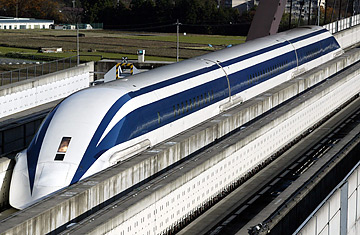
A maglev train in Yamanashi, Japan
For over a decade, Japan has been experimenting with electromagnetic trains at a testing facility in Yamanashi prefecture, about 50 miles west of Tokyo. The repulsion created between magnets embedded in the U-shaped track and others embedded inside the cars causes the train to levitate 10 cm above the bottom of the track — "maglev" is short for magnetic levitation. The magnets also propel the train forward very, very quickly, in part because air creates less friction than rail. The Yamanashi test maglev set a world speed record for trains in 2003 at 361 mph, and it cruises at 310 mph.
Right now, however, the maglev only travels the length of the 11-mile test track at Yamanashi, and as I discovered, that's a very, very quick ride. The train begins moving on wheels; the levitation doesn't kick in until the cars reach 81 mph. After a bump and release, as you would feel aboard a plane leaving the runway, it's pure, even, rapid acceleration to 310 mph. The only clue to the sheer speed is the tunnel lights outside: Standing 40 feet apart, they seem to stretch and blend until they appear as a single white stripe; very Buck Rogers. Outside the train makes a searing boom sound as it rips the surrounding air, but inside the car is as quiet as an airplane cabin, if a bit bumpy. Even before you've grown accustomed to the speed, the ride is over, the maglev gliding to a gentle halt, ending on its wheels.
Motaki Terai, the project's engineering manager, assures me that bumpiness won't be an issue: "People will be able to drink hot coffee when we start commercial service." But that day may be a long time coming, because the maglev is as costly as it is speedy. Japan Rail (JR) Central, the ex-public company that operates the country's main shinkansen artery, has already spent nearly $2 billion developing the maglev. Building an operational line that would cover the 342 miles between Tokyo and Osaka —Japan's most heavily traveled rail route — would cost an estimated $70 billion. That price tag may be prohibitive for a country whose public debt is over 1.5 times its GDP and the largest in the industrialized world, and whose poplation is shrinking.
Maglev trains aren't particularly energy efficient either, using triple the amount of power of a bullet train while running at less than double the speed. In fact, the bullet train may be the best reason to leave the maglev on its test track. Terai counters that the maglev aims to compete with air travel, and that reducing travel time between Tokyo and Osaka to around one hour actually makes it faster than going by plane. But air travel makes up only a fraction of the short-haul market precisely because bullet trains are more convenient and almost as fast. (And they're getting faster — the express shinkansen does Tokyo-Osaka in two and a half hours, while this week a French train running on rails almost matched the maglev speed record.)
Rational objections have rarely stopped massive Japanese infrastructure projects in the past — hence that huge debt — and Terai insists that the maglev makes technological and financial sense. "For us as a company and Japan as a country, this is a 21st century project," he says. "We need speed." A nation that already rides the bullet won't be satisfied with anything less.
